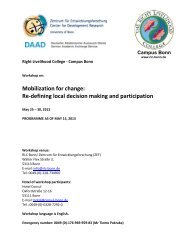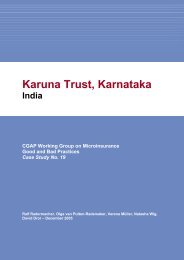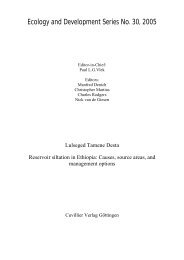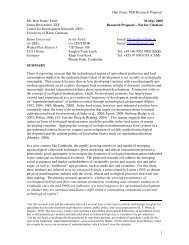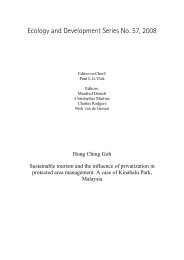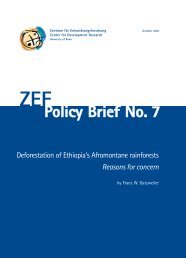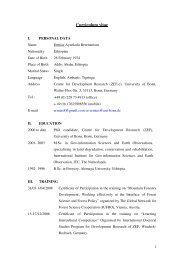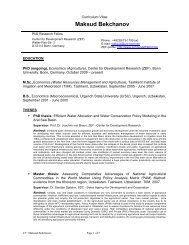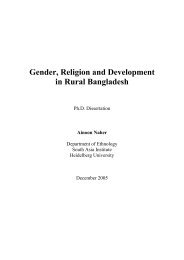Ecology and Development Series No. 10, 2003 - ZEF
Ecology and Development Series No. 10, 2003 - ZEF
Ecology and Development Series No. 10, 2003 - ZEF
- No tags were found...
You also want an ePaper? Increase the reach of your titles
YUMPU automatically turns print PDFs into web optimized ePapers that Google loves.
Current state of knowledgeThe largest collection of coffee accessions is found in Ethiopia under the auspicesof the Institute of Biodiversity Conservation <strong>and</strong> Research (IBCR). The current number ofstored accessions is about 4,500 <strong>and</strong> more are added every year. In addition, the JimmaAgricultural Research Center of the Ethiopian Agricultural Research Organization (EARO)maintains about 600 coffee types <strong>and</strong> 700 r<strong>and</strong>om selections of lines that show varyingresistance to the coffee berry disease (IAR 1986; Demel et al. 1998).2.4.2 In situ conservation methodsVery little progress has been made in the development of the scientific principles needed toevaluate in situ genetic conservation <strong>and</strong> to monitor respective activities, despite itsgrowing popularity <strong>and</strong> relative importance. This conservation method is still at its infancy<strong>and</strong> much more has to be done for success. However, given the nature of occurrence ofplant genetic diversity, three main methods of in situ conservation can be recognized(Maxted et al. 1997): conservation in "gene reserves", on-farm <strong>and</strong> in homegardens.Gene reserve conservationThis involves the location, designation, management <strong>and</strong> monitoring of genetic diversity ina particular, natural habitat. This method is the most appropriate for the bulk of wildspecies, whether closely or distantly related to crop plants. It permits multiple speciesconservation in a single reserve. The disadvantages are that the conserved material is notimmediately available for agricultural exploitation <strong>and</strong>, if the management regime isminimal, little characterization or evaluation data may be available. In the latter case, thereserve management may often be unaware of the genetic diversity of species that shouldbe conserved or even of the complete floristic composition of the reserve.Despite the development of the ex situ conservation methods described above, insitu conservation still remains an important element of the overall strategy for the long-termconservation of the Coffea gene pool. However, no gene reserves exist that have been setup specifically for the conservation of the wild gene pool of Coffea (Dulloo et al. 1998).There was a plan to establish ‘natural parks’ in three administrative regions of Ethiopia forthe in situ conservation of Coffea arabica, namely: Kaffa, Illubabor <strong>and</strong> Bale (Melaku <strong>and</strong>24



